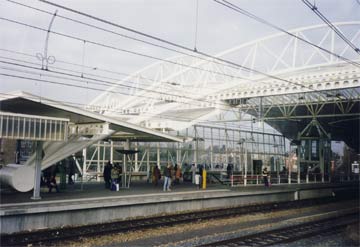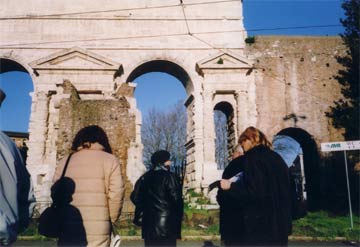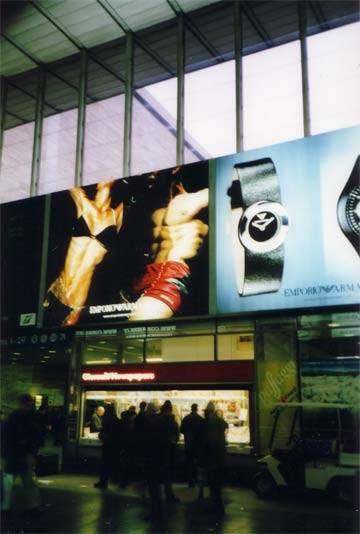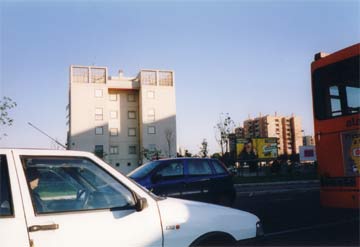Rome - A Fusion of History
|
|
The railway station in Holland is typical of many projects completed in Europe in the High-Tech manner. Here the decorative potential of tubular steel detailing is maximised completed with chrome bolt heads and stainless steel pins. This style of building was first made popular by the success in the late eighties and the nineties of the work of Norman Foster, Richard Rogers and Renzo Piano, before it became a cliché. Aside from some harbourside work by Piano at his home town of Genoa, Italy didn't take to this style and you see very few examples of this approach. In Rome there is the roof over the Olympic Stadium erected for the Italia 90 World Cup tournament which has massive exposed cantilevered trusses. The design solution for the roof over San Siro Stadium however was much more complex structure based on a lacework concept avoiding the explicit "High-Tech" cliché and still looks impressive 10 years after while the solution in Rome now looks rather dated.
High-Tech is the latest in a series of architectonic idea that became passé. At first the proponents of the modern style represented themselves as being solid creatures interested solely in function, practicalities and social needs suggesting that appearances were merely the by-product of the expression of the building's purpose, suggesting therefore that their architectonic aims were morally valid through the objectivity of their methodology. But as we study the past century of stylistic development and experimentation, it becomes absolutely clear that ever since the idea of dropping classical ornaments took hold, architects and designers had been pre-occupied with nothing much else but visual style and aesthetics despite their intellectual justifications about scientific objectivity.
It would be fair to say that in the last thirty years or so, this pre-occupation in the profession has become an obsession. Architects no longer prepare plans, they create "concepts". So what architectonic intentions drive these concepts? Simply put it is none other than a search for beauty. They in their philosophy might say beauty is not the word but no matter what one calls it, it doesn't change their desire to arrive at that elevated sense of being. This they believe is good for everyone and perhaps it is so. It is a beauty which they strive to achieve by making an "impact" by the means of a series of what are essentially visual effects created by a deliberate distortion of formal norms. In this respect it is actually a maddening search but in my view every modernist architect is looking to be the author of that magic formula which will definitively substitute once and for all the idea of classical beauty. Therefore there are self imposed restrictions on their aesthetic vision which preclude any hint of traditional lineage in their so called "innovations". Some architects such as Odile Decq, Rem Koolhaas and Zaha Hadid, with their odd angles, seem to be convinced that they have actually arrived at that formula. I would call their game 'origami'.
I recently watched again on Video the film starring Keanu Reeves, "The Matrix" and believed that I
understood more of the sub-text which escaped me the
first time. Inside what appears to be a complete fantasy there is an intriguing exploration of
modernity and religion. To make it palatable it is well masked by the cutting edge cinematography full of
slick costumes, fast action and gadgetry.
There is also a condition that the film demands of its audience just as much as it does to its protagonist. That is, we too must choose to take the red pill or the blue pill. How the film is perceived is entirely dependent on that decision. Most of us I think might take the red pill. Watch the film again to see what I mean but what I want to say here is that belief systems in modern society seems to be diverging into two separate, perhaps irreconciliable parallel realities. represented by the contradictory approaches taken by modernists and traditionalists towards urban design. Each camp tends to exclude consideration of the other in their social and architectonic schemata.
Whether one has sympathies with traditionalists or modernists, if one project embodies its own ideals at the exclusion of the other. How can we move ahead with the grander project of overall urban coherence? What will unify history with the exigencies of zeitgeist?
As it has done in the past, perhaps Rome is poised to provide some answers.
The other day, as it had done last summer, the Coloseum was the venue for a free mega-concert
sponsored by the Comune of Rome. It was
the turn of Simon and Garfunkel. Last year's guest was Paul McCartney. The audience was estimated to be around 500,000 standing
all the way down the Fori Imperiali to Piazza Venezia. I managed to find a spot just at the corner of Via Cavour. The stage
was erected in front of the towering elevation of the Coloseum. It was spectacular. With the glistening
temporary stage (made of stainless steel) and Maxi-Screens erected every 100 metres down the street.
The elaborate stage lighting and the illumination system on the Coloseum itself changed colours
with the mood of the various old songs. The full moon seemed to smile as it rose from behind the Coloseum
just as the concert was starting,
with the theme song "Old Friends". It was more than just a concert of nostalgia. For two hours time seem to stop as
the divide of across antiquity, modern history, experience, poetry, music, language, space, digital technology, sound mixing,
people and memory suddenly fused into a single sensation. I heard the songs "The Boxer", "Mrs Robinson", I am a Rock, etc. as
a boy from the radio in Seoul back in 1970. Simon and Garfunkel were my heroes then and their words and music
are intimate since I do
my own renditions of several of their songs. Their voices are entrenched as part of my emotional history,
as a part of my dream life. On a balmy Roman night, in front of the Coloseum they became real people for me.
They built a little bridge back to the best memories of my adolescence.
It also reinforced the reasons why I live here. Only Rome has the places with that kind of power; the capacity to
humanise, to scale back such an over-sized modern, technological event into a deep personal experience.
Siracusa, 25 7 2004



